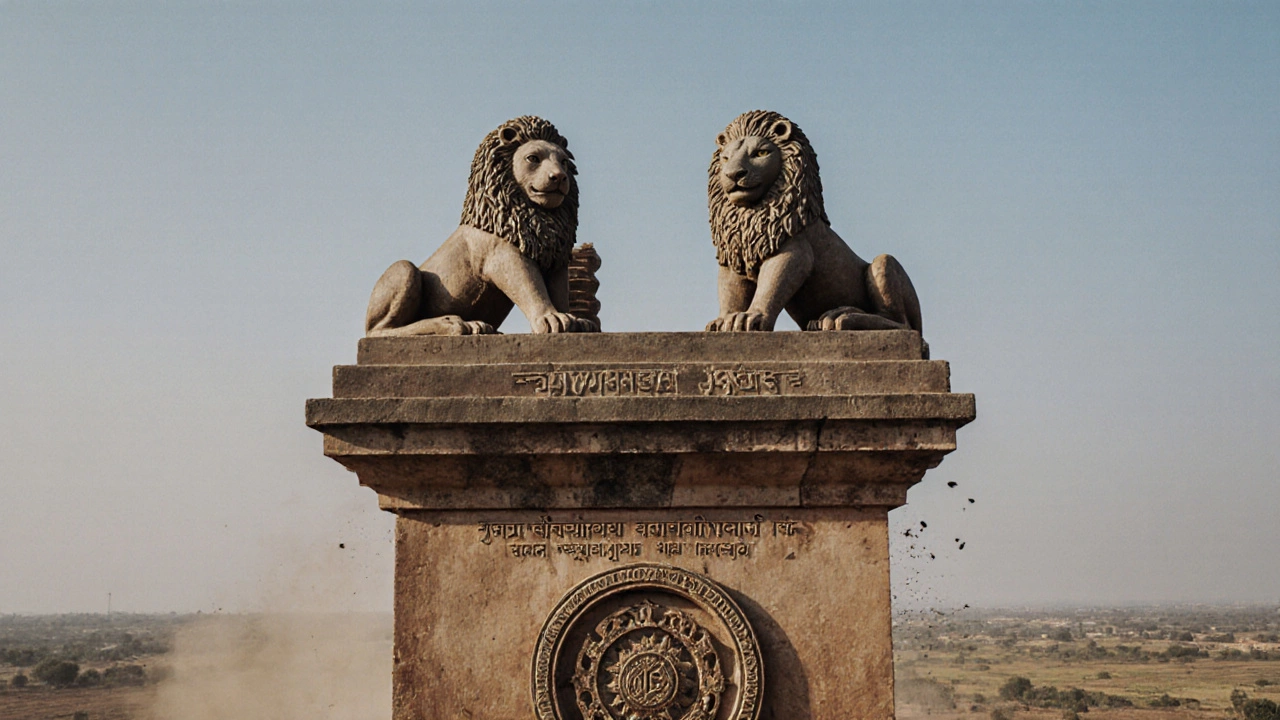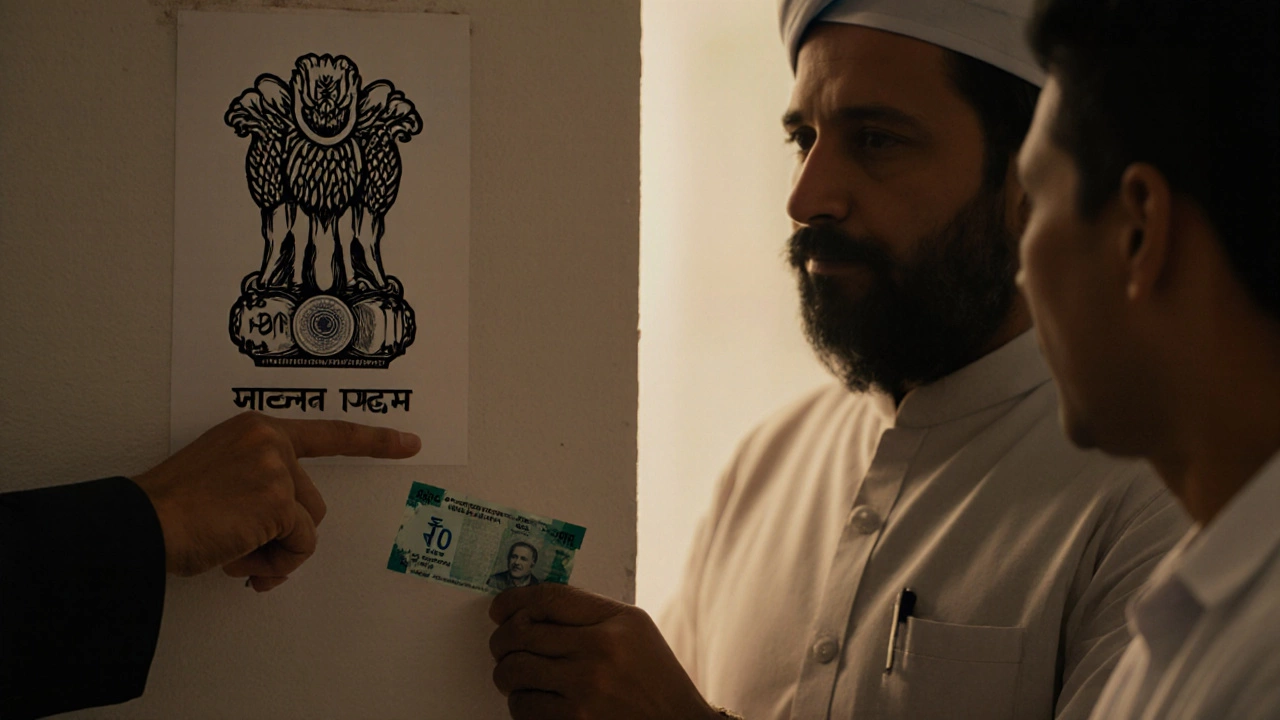When people ask about the national quote of India, they often expect something grand-something poetic, powerful, maybe even shouted from the ramparts of history. But the truth is quieter, older, and far more rooted in ancient wisdom than most imagine. India doesn’t have a national slogan like ‘Liberty, Equality, Fraternity’ or ‘E Pluribus Unum.’ Instead, it carries a single phrase, carved into its state emblem, whispered in classrooms, printed on currency, and engraved on government buildings: Satyameva Jayate.
What Does Satyameva Jayate Mean?
Translated literally, Satyameva Jayate means ‘Truth alone triumphs.’ It’s not a call to arms or a political manifesto. It’s a quiet, unshakable belief-one that’s been passed down for over 2,500 years. The phrase comes from the Mundaka Upanishad, one of the oldest Hindu philosophical texts, written in Sanskrit. This isn’t a modern invention. It’s not even from the independence movement. It’s from a time when India’s thinkers were exploring the nature of reality, knowledge, and ethics.
The full verse reads: satyameva jayate nānṛtaṃ, satyena panthā vitato devayānaḥ-‘Truth alone triumphs, not falsehood. Through truth, the divine path is spread.’ That’s not just a quote. It’s a worldview. It says truth isn’t just morally right-it’s the only thing that lasts. Lies fade. Deception crumbles. But truth? It endures.
How Did It Become India’s National Motto?
India didn’t pick this phrase lightly. After gaining independence in 1947, the Constituent Assembly spent months debating what should represent the new nation. They looked at slogans from the freedom struggle-‘Do or Die,’ ‘Quit India,’ ‘Inquilab Zindabad’-but those were battle cries. They wanted something timeless. Something that reflected India’s civilizational depth, not just its political fight.
In 1949, the emblem of India was officially adopted. It’s based on the Lion Capital of Ashoka, a 3rd-century BCE sculpture from Sarnath. Ashoka, one of India’s greatest emperors, had embraced non-violence and truth after the bloody Kalinga War. He carved edicts across the subcontinent urging justice, compassion, and truth. The Lion Capital, with its four lions standing back to back, was chosen as the national emblem. And beneath it, the words Satyameva Jayate were inscribed in Devanagari script.
That’s why you see it today on official letterheads, passports, currency notes, and government buildings. It’s not decorative. It’s a promise. A reminder to those who hold power: govern with truth, or you will fall.
Why Not Other Famous Indian Quotes?
You’ve probably heard other quotes attributed to India’s leaders. Gandhi said, ‘Be the change you wish to see in the world.’ Nehru spoke of ‘tryst with destiny.’ Tagore wrote poetry about freedom and light. These are powerful. But none of them are official. None are on the national emblem. Why?
Because those are personal expressions. Satyameva Jayate isn’t tied to a person. It’s tied to a tradition. It doesn’t belong to Gandhi or Nehru. It belongs to the Upanishads. It belongs to Ashoka. It belongs to the collective conscience of a civilization that has survived invasions, empires, and colonial rule-because it held on to something deeper than power: truth.
Some people think India’s national quote should be something in Hindi or English. But the choice of Sanskrit was deliberate. Sanskrit isn’t just a language-it’s the vessel of India’s oldest philosophical systems. Using it signaled that India’s identity wasn’t borrowed from Britain or shaped by modern politics. It was drawn from its own soil, its own thinkers, its own silence.

What Does It Look Like Today?
If you walk into any Indian government office, you’ll see the emblem on the wall. The four lions stand tall. Below them, the wheel of law-the Ashoka Chakra-spins silently. And beneath that, the words Satyameva Jayate in elegant Devanagari. In courtrooms, judges swear oaths on it. In schools, children recite it during morning assemblies. On the back of every ₹10 note, it’s printed in small letters, next to the portrait of Mahatma Gandhi.
It’s not loud. It doesn’t demand attention. But it’s always there. Like a heartbeat. You don’t notice it until you look for it. And then you realize-it’s the foundation.
Is It Still Relevant in Modern India?
That’s the real question. In a country where corruption scandals make headlines, where misinformation spreads faster than truth, where political rhetoric often replaces facts-does a 2,500-year-old phrase still mean anything?
Yes. Because it’s not a slogan for politicians. It’s a mirror for citizens. When a teacher tells a student to speak the truth, even when it’s hard-that’s Satyameva Jayate. When a whistleblower exposes fraud, even at personal cost-that’s Satyameva Jayate. When a farmer refuses to sell fake seeds, even when he’s poor-that’s Satyameva Jayate.
It’s not about grand gestures. It’s about daily choices. The quote doesn’t promise victory. It promises endurance. Truth doesn’t always win immediately. But it always wins eventually. That’s why it’s India’s national motto-not because it’s pretty, but because it’s true.

How Is It Used in Everyday Life?
You won’t find Satyameva Jayate on T-shirts or Instagram captions. But you’ll find its spirit everywhere.
- In the Indian judiciary, where judges cite it in landmark rulings.
- In the Indian Space Research Organisation (ISRO), where accuracy is non-negotiable.
- In the Indian Constitution, where the preamble begins with ‘We, the people of India…’-a declaration rooted in truth.
- In rural villages, where elders still say, ‘Sacchā bolō’-speak the truth.
It’s not just on government buildings. It’s in the way people speak to their children. In the way students study for exams. In the way doctors refuse bribes. In the way journalists risk their lives to report facts.
Common Misconceptions
Let’s clear up a few myths:
- Myth: ‘Inquilab Zindabad’ is the national quote. Reality: It was a revolutionary slogan used during the freedom struggle. Never official.
- Myth: Gandhi’s ‘Satyagraha’ is India’s motto. Reality: Satyagraha is Gandhi’s philosophy of non-violent resistance. It’s inspired by Satyameva Jayate, but it’s not the same.
- Myth: The quote is in Hindi. Reality: It’s in Sanskrit. Hindi is a modern language. Sanskrit is ancient. The choice was intentional.
- Myth: Every country has a national quote. Reality: Most don’t. India’s is rare because it’s philosophical, not political.
Why This Matters Beyond India
In a world drowning in fake news, deepfakes, and manufactured outrage, Satyameva Jayate feels more urgent than ever. It doesn’t ask you to be loud. It asks you to be honest. It doesn’t demand you win the argument. It asks you to stand by what’s real.
That’s why this quote matters-not just for Indians, but for anyone who believes truth still has value. It’s not a relic. It’s a responsibility. And it’s not just on a coin or a building. It’s in you. Every time you choose honesty over convenience, you keep it alive.
Is Satyameva Jayate the only national symbol of India?
No, it’s one part of a larger set. India’s national symbols include the national flag, the national animal (tiger), the national bird (peacock), the national flower (lotus), and the national tree (banyan). But Satyameva Jayate is the only official national motto. It’s the only phrase legally tied to the state emblem and used across all government institutions.
Who wrote Satyameva Jayate?
The phrase comes from the Mundaka Upanishad, an ancient Sanskrit text that’s part of the Vedas. It was not written by a single person but passed down orally by sages for centuries before being compiled. The exact author is unknown, as is common with Vedic literature. It’s a collective spiritual inheritance, not the work of one individual.
Why is it written in Devanagari script and not English?
Because it’s a cultural and spiritual anchor. Devanagari is the script used for Sanskrit and Hindi, and it connects the motto directly to India’s ancient philosophical roots. Using English would have made it feel like a colonial import. Choosing Devanagari was a deliberate act of cultural reclamation after centuries of British rule.
Does every Indian know what Satyameva Jayate means?
Most schoolchildren learn it by heart. Many adults understand the meaning, even if they can’t translate it perfectly. In urban areas, people may know the phrase but not its origin. In rural areas, the concept of truth as a guiding principle is often lived more than explained. The phrase’s power lies in its simplicity-it doesn’t need translation to be felt.
Can I use Satyameva Jayate on my personal items like T-shirts or logos?
Technically, the state emblem-including the phrase-is protected under the State Emblem of India (Prohibition of Improper Use) Act, 2005. Using it for commercial purposes, advertising, or personal branding without permission is illegal. However, using the phrase alone-without the lions or Ashoka Chakra-is generally acceptable in educational or artistic contexts, as long as it’s not used to mislead or mock.
